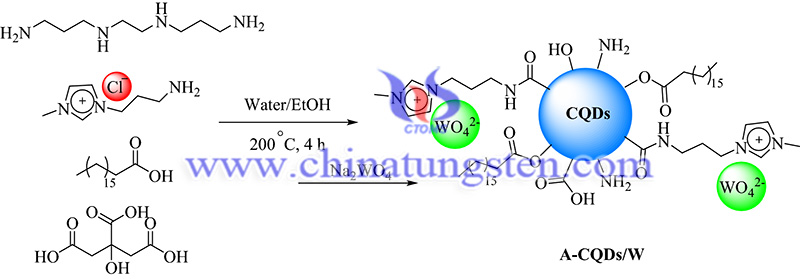Ultrasound-Assisted Tungstate Catalyst for Oxidation of Alcohols to Aldehydes
- Details
- Category: Tungsten Information
- Published on Thursday, 31 March 2022 17:35
The application of ultrasound (US) as a green activation method for the chemical conversion of tungstate catalyst to oxidize alcohols to aldehydes has attracted chemists’ interest.
In a study collaborated by Iranian and Chinese researchers, to realize the idea of designing an eco-friendly system to oxidize alcohol substrates to the corresponding aldehydes, the researchers developed multifunctional tungstate-decorated CQD-based catalysts A-CQDs/W and examined their sonication performance in the presence of H2O2 as a green oxidant in an aqueous medium. By comparing the performance of the catalysts in oxidizing benzyl alcohol to benzaldehyde (BeOH) before and after irradiation, the key role of ultrasonic irradiation in achieving high yields can be derived.

Catalytic alcohol oxidation is a common method for the synthesis of aldehydes, but despite the good results achieved in many cases, establishing an eco-friendly method to produce these intermediates with high yields and selectivity remains a major challenge. In order to put some green chemistry standards into practice, the amount of harmful and toxic solvents and reagents should be kept to a minimum or replaced by non-toxic and non-hazardous materials, in addition to minimizing the energy consumption in the reaction.
So far, among the new green activation methods: photochemistry, microwave, biotransformation, and ultrasound, ultrasound is adapted to green chemistry principles in chemical transformation.
A well-known application of ultrasound in chemistry is related to the degradation of water contaminants. Ultrasound is used as a green activation energy source for the synthesis of various chemicals, which not only eliminates the need to apply external heating to carry out the reaction but also reduces the number of catalysts, hazardous solvents, and polluting PTCs used.
Stirring excited by shock waves generated by ultrasound can enhance mass transfer to a much greater extent than conventional magnetic stirring. As a result, reactions can proceed at a faster rate than conventional thermally activated reactions due to significant reagent interactions, specific heat, and pressure.

In this way, high yields can be obtained with minimum reaction time and minimal catalyst usage, while the amount of waste and by-products can be kept to a minimum. However, despite the many advantages of using sonication for chemical synthesis, only a few reports have used sonication for selective oxidation of alcohols to aldehydes with auxiliary tungstate catalyst.
The researchers used ultrasound to catalyze the oxidation of benzyl alcohol to BeOH with high efficiency using (dodecyl tungstate) as a homogeneous catalyst.
The tungstate anion WO4 is widely utilized in catalytic alcohol oxidation practice as a powerful activator for alcohol oxidation or epoxidation of alkenes to the corresponding aldehydes or ketones. Although the proper stabilization of these species on the catalyst carrier to keep metal etching at a minimum level remains a great challenge.
Moreover, the tungstate catalyst can be considered one of the cheapest catalysts in terms of total catalyst cost and have valuable properties such as great catalytic activity, non-toxicity, availability, good oxygen-carrying capacity, and great ability to activate H2O2, which makes them an attractive article for oxidation purposes.
By introducing ultrasound, the selective oxidation of alcohols to aldehydes by tungstate catalyst can be easily performed at ambient temperature and pressure, thus avoiding the need for reflux setups and significant time and effort to complete the oxidation reaction. In this way, some of the principles of green chemistry, such as prevention, atomic economy, less hazardous chemical synthesis, design of safer chemicals, safer solvents and additives, energy efficiency, reduction of derivatives, and operational safety can be achieved.
The study titled “Ultrasound‑assisted pseudohomogeneous tungstate catalyst for selective oxidation of alcohols to aldehydes” has been published in Nature Scientifc Reports (2022) 12. The study was carried out by Aram Rezaei, Yasaman Mohammadi, Ali Ramazani, and Huajun Zheng.
- Tungsten Manufacturer & Supplier, Chinatungsten Online: www.chinatungsten.com
- Tungsten News & Prices of China Tungsten Industry Association: www.ctia.com.cn
- Molybdenum News & Price: news.molybdenum.com.cn
- Tel.: 86 592 5129696; Fax: 86 592 5129797; Email: sales@chinatungsten.com



 sales@chinatungsten.com
sales@chinatungsten.com